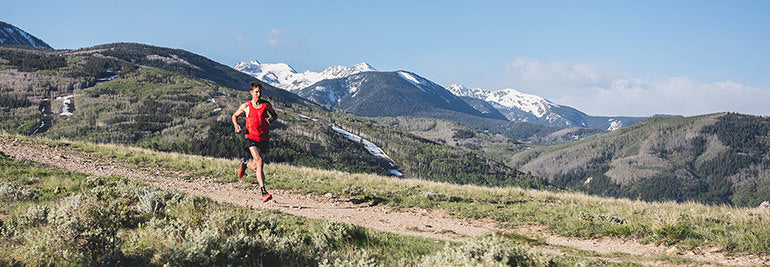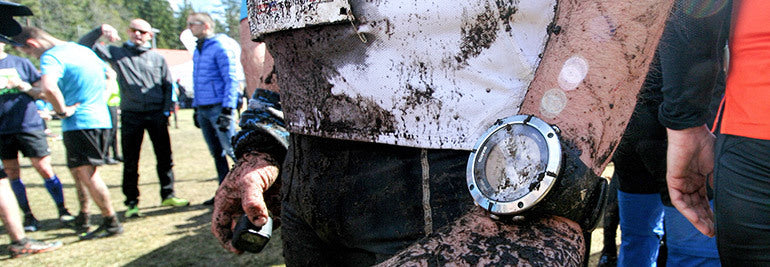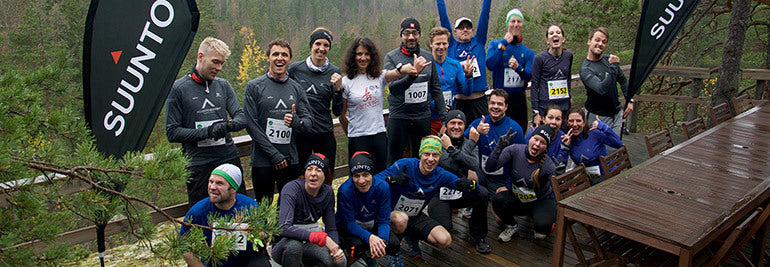

Suunto Blog

How do I run?
We are happy to launch How do I run, a three-week campaign designated to make you a stronger runner! We have partnered with XTERRA World Champion and professional coach Josiah Middaugh to get you the best tips and tricks and with CTS to offer you a chance to get personal feedback on your running technique.
Learn more about running technique
Josiah Middaugh is the right man to talk to about becoming a stronger runner. Josiah is the 2015 XTERRA World Champion and also a professional coach. He certainly knows what it takes to make you run faster – or more efficient.
“Running economy is the holy grail for distance runners, not a high VO2 max,” Josiah says.
Josiah Middaugh is your running expert during the campaign.
In the first of his three articles on running technique Josiah introduces five proven ways to improve running economy. Read the article here and stay tuned for more tips and tricks in the following weeks!
Update on May 31: The second #howdoirun article is out! Read also Josiah's Intro to distance running technique
Update on June 8: Time to practice! Try Josiah's 8 Essential running form drills
Get feedback on your running
To put Josiah’s advice in action we are offering you a unique opportunity to get personal feedback from a professional running coach.
To participate get your friend to film a video clip of you running. For best results – and footage that can be analyzed – a side view is preferable. Choose a flat, straight stretch of trail or road and run at a relaxed pace.
Upload the video on Instagram and tag it with #howdoirun between May 24 and June 11. Professional running coaches Jason Koop and Adam St. Pierre from CTS will analyze the most interesting videos daily.
Three of the most inspiring videos will win Suunto Spartan Sport Wrist HR watches. You can find the detailed contest terms and conditions here.

Suunto Summit 2017 Recap
The post-race sauna and making new friends with some reindeer might have helped but really we came to realise our connection is rooted in our shared passion for sport and the outdoors.
"Meeting outdoor enthusiasts from all over the world and learning their stories and sharing our passion for different sports was truly inspiring." -Philipp Reiter, trail runner and photographer, Germany (Image by Oskar Henriksson)
"The Suunto Summit was a great experience that felt like i was a part of a family with a shared passion for the outdoors." -Arnau Martorell Sala, Spain
"The summit brought a whole new, and overwhelming sense of joy to meet so many open and strong athletic women who are excited to get out there. It was comforting to not feel alone or intimidated." Mia Morandi, USA.
"Listening to all the experiences of my fellow Suunto Summiteers has left me inspired and completely in awe…and mingling with the team behind Suunto was absolutely invaluable. It has been such a privilege to be here." -Ramon Fadli, Malaysia.
"Bravo! I’ve loved Suunto 20 years, I love you even more…" -Barbara Edelston Peterson, USA
"It really has been a unique experience and a wonderful opportunity to meet the people at the heart of Suunto and to leave Helsinki feeling part of the family. Thank you all, you guys rock!" -Tim Major, UK
We are grateful to have shared the experience with such an incredible group, and agree with one of our participants, Pelle Nyberg, from Sweden, that the "Suunto Summit captures the essence of the community."
All images by Philipp Reiter

VO2 MAX IntervalS with XTerra champion Josiah Middaugh
In modern times, interval training is a fundamental way to train endurance performance. I overheard my 10-year-old telling his brother, “the best way to get faster is to do intervals, that’s what my gym teacher said.” For the general public, any intervals will do, but for the highly trained endurance athlete we need to get a little more scientific.
The basic premise of interval training is that you are able to swim, bike, or run at a higher intensity if your training is intermittent versus continuous. A 5k runner, for example, could head out the door and cover 3.1 miles as fast as possible a couple times a week, but would have a hard time holding their goal pace for much more than one mile. Instead, if the training was broken into half mile intervals, a race-pace could be achieved with every 800 meter bout as long as recovery was adequate. With each repeated bout there is a cumulative effect, up to a certain point, to stimulate adaptation. Beyond a certain point, maladaptation can occur.
Types of Intervals
In an effort to simplify we will focus our discussion on the most potent type of intervals known as VO2 max intervals. VO2 max is defined as an individual’s highest rate of oxygen consumption (milliliters of oxygen per kilogram of body weight per minute). A common misconception is that interval training is strictly anaerobic. These types of intervals do have a big anaerobic component, but by definition have you operating near your peak oxygen consumption, which is the key. Most athletes can work at VO2 max for only about 5 to 9 minutes, so intervals at VO2 max need to be shorter than that. If the interval is too short, then the anaerobic contribution is big, but there is not enough time to actually get to VO2 max. Personally I like 2-3 minutes ON with about equal recovery.
Pacing Strategy
Pacing is critical. Suppose you are running those 800 meter bouts and you start out by sprinting the first 200 meters and then have a gradual slow-down for the next 600 meters. Your average pace might be on target, but you have failed to reach VO2 max since you started with this huge anaerobic effort and then settled into a pace slower than your VO2 max intensity.
There is something called a slow-component to VO2 max. This means that for any pace above lactate threshold, you will eventually reach VO2 max if the exercise is continued. So you do want to go fast, but to spend the most amount of time near VO2 max, you want a pace you can sustain for 2-3 minutes. If performed correctly your oxygen consumption will approach VO2 max about half-way through each hard effort. So if your workout is 6 x 2.5 minutes, you might in reality only spend a total of 7.5 minutes at VO2 max, which is fine. If performed poorly you may only spend a few seconds of each interval at VO2 max or none at all.
Graph 1: Poor pacing strategy with high power output (purple) at the start of each bout and power dropping on each bout.
Graph 2: Better pacing strategy here. In this case, power (purple) within each bout was very consistent, but there was still a drop off in power for the last 3 bouts.
Graph 3: Power (white) fairly consistent throughout hard efforts. Notice peak heart rate (orange) is not achieved until the 6th bout. Different athletes, different software.
Work:Rest Ratios
An ideal range for work portion is about 1.5 to 4 minutes. We like the 2-3 minute range the best with a few exceptions. Work to rest ratios are usually around 1:1. The rest interval can be adjusted to increase or decrease the intensity of the workout. If you are having a hard time keeping pace, try adding 30 seconds rest. If you are completing the workout with energy to spare, try 30 seconds less rest the next time out.
How Intense?
Pace or power are your best guides for this type of training. Heart rate lags so far behind that it is not the best indicator and you don’t want to try to spike your heart rate to start each effort.
If you have power on the bike, I like to use 110% FTP for 3 minute bouts, and 115% FTP for 2 minute bouts.
For running, a 5k race pace or slightly faster will get you there. A 15 minute 5k runner can just use their 5k pace, but a 25 minute 5k runner might need to increase the pace slightly.
If you are performing intervals uphill and don’t have power or pace to guide you, try this approach. Warm up to the base of consistent climb. On your first bout, hold back a fraction and note your distance at 1 minute and 2 minutes. Make a mark in the dirt. Recover on the downhill and repeat the same section of the hill attempting to at least reach the same finishing mark or go slightly further. Try to do this without going any further for that first minute.
How Much?
I mentioned earlier that this is the most potent form of training. So your goal is to be able to maintain the quality for the entire workout. For most people this means 15-21 minutes of total hard work. So that is 8-10 bouts of 2 minutes, or 5-7 bouts of 3 minutes. Keep it simple. Shoot for a very similar intensity every time and if you start to slow down you have done too much.
How Often?
A little bit can go a long way. I try to space out this type of training more than any other. For most people that means two quality sessions per week with one on the bike and one on the run. Training becomes more polarized during a VO2 max cycle with recovery and endurance workouts separating VO2 max bouts. Total training volume is reduced and avoid excessively long workouts during this time.
Soon Ripe, Soon Rotten
With this type of training, most people will plateau in about 6 weeks. I like to sprinkle in this type of training as key races are approaching and save heavy blocks of VO2 max interval training for the most important races of the season.
Josiah Middaugh is the reigning XTERRA Pan America Champion and 2015 XTERRA World Champion. He has a master’s degree in kinesiology and has been a certified personal trainer for 15 years (NSCA-CSCS).
Get to know Josiah
Learn how to use Suunto Spartan's Interval feature

Suunto Summit 2017
Watch the video and experience the first ever Suunto Summit that was held in October, 2016.
We are thrilled to share the selections for the Suunto Summit 2017. After hosting an open, public application process, we received inspiring motivation letters and stories from all around the world.
Within our final group we have authors, awarding- winning photographers, influential bloggers; we have XTERRA world-champions, and winners of major ultra-trail races. Balancing these inspiring experiences and accomplishments was a challenge, but we are thrilled to have had so many inspiring applications that shared a synonymous passion for being a part of the Suunto community.
Stats:
6 female, 9 male
9 from Europe (2 France, 1 Spain, 1 Finland, 2 Sweden, 1 Norway, 1 Latvia, 1 UK, 1 Switzerland)
2 from USA, 1 from New Zealand, 1 China, 1 Malaysia.
Suunto Summit 2017 participants:
Arnau - Spain
Diane-Perle - Switzerland
Marta - Latvia
Marit - Norway
Mia - USA
Barbara - USA
Petra - New Zealand
Ramon - Malaysia
Sebastien - China
Pelle - Sweden
Jean-François - France
Tim - United Kingdom (UK)
Mathias - France
Sante - Finland
Oskar - Sweden
Congratulations to all selected, and a huge thank you to all who applied and shared their passion with us!
- Suunto Team

World Vertical Week 2017 Big Data: See who stands on the top!
The World Vertical Week is about collecting vertical meters for your country and your sport. All moves in all human-powered outdoor sports count. To keep the playing field level, we were only comparing averages. A cumulative number of ascent meters per country would not have made sense as the population and number of Suunto App users varies.
Skiers are still quite clearly the queens and kings of the hill with 849 meters of ascent in average. The mountaineers climbed on the second spot with 636 meters and the trail runners rounded out the top three with their 400 ascent meters.
Actually the order of the activities remained almost identical compared to 2016: the only difference was that mountain bikers passed the snowshoers in the listings.
Average ascents in various activities
Ski touring 849m
Mountaineering 636m
Trail running 400m
Mountain biking 362m
Snow shoeing 316m
Trekking 293m
Cycling 236m
Cross country skiing 222m
Running 104m
SKI TOURING IS NUMBER ONE – BUT WHO SKIS THE MOST?
Now that we know that ski touring is the sport with the biggest average ascents, it is time to dig deeper. The snowy winter in the Pyrenees has boosted the skiing spirits of the Spanish and they were the only athletes to cross the thousand vertical meter mark – in any country and any activity. Felicitaciones, españoles!
Top 10 countries in ski touring
Spain 1034m
Switzerland 938m
Slovakia 936m
Germany 927m
Andorra 916m
Italy 909m
USA 883m
Austria 877m
Poland 874m
France 858m
A SLIGHT SURPRISE IN MOUNTAINEERING
Mountaineering was second in the activity listings. But the leading nation within that activity was a slight surprise: United Kingdom surely has a long mountaineering tradition, but only a few – at least here in the Suunto office – would have bet their money for the island nation. The UK was not among the top mountaineering nations last year, but still they took the first place with 836 meters in 2017.
Top 10 countries in mountaineering
United Kingdom 836m
Italy 772m
Switzerland 749m
Germany 713m
Japan 685m
France 683m
Austria 655m
Taiwan 620m
USA 600m
South Korea 575m
ASIAN COUNTRIES DOMINATED TRAIL RUNNING
It was clear already last year that China, Hong Kong and Japan are strong in the trail running segment. This year they occupied the top three with excellent performances and clear margins.
Maybe having the Vertical Week in winter limits the possibilities for trail running in mountainous areas in Europe and North-America but still the Asian performance was impressive. Great climbing, China, Hong Kong and Japan!
Top 10 countries in trail running
China 887m
Hong Kong 808m
Japan 711m
Italy 572m
Portugal 540m
Spain 524m
United Kingdom 509m
Slovenia 469m
Greece 468m
Austria 437m
CLOSE MARGINS IN COUNTRY COMPARISONS
We also analysed the data for all human powered outdoor sports and compared the average ascents between countries. The margins were tight, but still there was one above the rest: The Austrians ascended on average more than any other nation, 320 meters per every workout tracked during the Vertical Week.
Top 10 countries overall
Austria 320m
Italy 298m
Switzerland 287m
Spain 261m
Slovenia 261m
Portugal 258m
Hong Kong 247m
France 240m
Norway 235m
Slovakia 218m
TOP COUNTRIES IN OTHER ACTIVITIES
And to give you even more to speculate here are the top countries in the other activities mentioned above.
Top 10 countries in mountain biking
Italy 515m
Slovenia 479m
Spain 471m
United Kingdom 465m
Austria 461m
Switzerland 443m
South Africa 416m
France 370m
Germany 367m
Poland 366m
Top 10 countries in snow shoeing
Italy 564m
Andorra 530m
Austria 510m
Germany 429m
France 424m
Switzerland 345m
USA 228m
Spain 213m
Canada 178m
Finland 163m
Top 10 countries in trekking
France 406m
Italy 397m
Austria 353m
Poland 322m
Spain 307m
USA 274m
Germany 271m
Norway 243m
United Kingdom 229m
China 141m
Top 10 countries in cycling
Spain 405m
Italy 403m
South Africa 393m
Colombia 392m
Portugal 355m
Cyprus 332m
Switzerland 328m
Czech Republic 308m
France 298m
Austria 294m
Top 10 countries in cross country skiing
Czech Republic 391m
France 312m
Poland 286m
Norway 270m
Sweden 266m
Italy 260m
Austria 252m
Canada 225m
USA 222m
Germany 221m
Top 10 countries in running
Portugal 157m
Hong Kong 151m
Slovenia 148m
Switzerland 136m
France 128m
Spain 127m
Norway 126m
New Zealand 124m
USA 117m
Czech Republic 115m
Main image © Patitucci Photo

Hollie, Sami and Christoph are the Vertical Week photo contest winners
World Vertical Week was held last week and the hundreds of pictures tagged with #verticalweek on Instagram give a great overall look into what people have been up to during the week. Three of the most inspirational photos were taken by Hollie Holden, Sami Renner and Christoph Oberschneider. Each one of the winners will receive a new Suunto Spartan Ultra to accompany them on their future adventures.
🌲// Legs/entire body felt like an 🐘 at this weeks @vanrunco trail ✈️ crew BUT I managed to hit my @suunto #VerticalWeek goal of 4000m (1k more than my 1st goal! 🙌) of climbing and we were blessed with a pretty layer of 'convenient snow', right @coralie2700 ? 😉🤣❄️
A post shared by Hollie Holden (@holholden) on Mar 5, 2017 at 12:59pm PST
“The Vertical Week was a great opportunity for me to start building my strength and climbing skills ahead of my upcoming training season for my 1st 50 mile Ultra Marathon - the Squamish 50 in August which is a tough, mountainous course with 11,000 feet (3350m) of climbing!
I set myself the goal of covering a similar amount of climbing during Vertical Week so I spent a lot of time on a local trail called the BCMC which starts at the base of Grouse Mountain climbing to the top. This trail has 850m of elevation gain in just 3km of climbing! I ended up doing this trail 4 times in the week (3 times within one 24hr period!) then finished off the week running trails with my local run crew, Vancouver Running Company Flight Crew, surpassing my 3k goal and hit 4000m for the week instead!
The weather in Vancouver has been unseasonably cold, with lots of snow & wet rain and I wouldn't have done anywhere near as much climbing last week if it wasn't for the awesome community of friends that I have here who are willing to come climb mountains in a snow storm with me!”
–Hollie Holden, BC, Canada
Cause she asked so friendly... 🐦 #lovemountains #skimo #verticalweek #collectingmoments #mountaineering #watzmann
A post shared by Sami (@samirenner) on Mar 5, 2017 at 10:10am PST
“The photo was taken on the last of three summits at the “Watzmann-überschreitung”, a famous summer tour in my hometown with over 24km and 2500m of climbing. The goal for me was to do this very technical tour with skis. As I reached the third summit, I shared my last Powerbar with a bird.
A few days earlier during the Vertical Week I was in Zermatt, reaching Breithorn’s (4164m) west and east summits on skis, and on two more skitours. All in all, my Vertical Week was about 7500m of elevation gain over 65km.”
–Sami Renner, Germany
Welcome back, #winter! Yesterday was a great #powderday in @visitgastein. Can't wait for more!
A post shared by Christoph Oberschneider (@coberschneider) on Mar 2, 2017 at 3:09am PST
“I work as a backcountry skiing photographer in Austria, so my goal each winter season is to capture the beauty of backcountry skiing & ski touring, to share my passion for the sport with as many people as possible and ultimately to get more people to enjoy life in the outdoors.
So far we have had a very dry winter here in the Alps, so getting good shots has not been an easy task. So when it finally started snowing 10 days ago, I headed out to Sportgastein (a freeride spot close to Salzburg) with two good friends. We found some beautiful lines in the backcountry with lift-supported ski touring and I managed to get some good shots. And that's how I also spent the rest of the Vertical Week, ski touring in the mountains around Salzburg and trying to capture the beauty of the winter landscape and some more skiing action before the snow starts melting again.”
–Christophe Oberschneider, Austria
Congratulations to our three winners and thank you very much everyone for sharing your Vertical Week moments!














































































